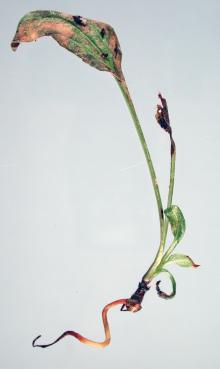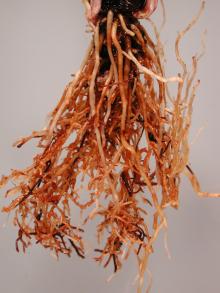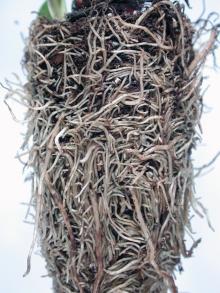See:
Coneflower (Echinacea spp.) - Stem Rot
Cause The OSU Plant Clinic has found several soilborne organisms associated with Echinacea root problems but mostly Fusarium sp. and sometimes Pythium sp. or Rhizoctonia sp. Damping-off, root and crown rots were diseases encountered.
Fusarium - The fungus is soilborne and can survive in soil, often in plant debris, for at least several year as durable resting spores known as chlamydospores. The fungus can be spread by infested equipment or windborne or waterborne movement of infested soil. They can sporulate on infected tissue and/or be moved by fungus gnats and shore flies.
Pythium - These organisms are favored by abundant moisture and can be especially problematic in poorly drained potting media. Pythium spp. can survive in dust, planting media, or soil particles on greenhouse floors, flats, and pots. Wood benches can also be a reservoir. Spread can also occur via movement of infected plants. These organisms enter roots damaged by high soluble salts, either from over-fertilization or from letting the rooting medium dry out, even for short periods, during propagation.
Symptoms Fusarium root rot - Affected plants show necrosis along leaf margins, followed by wilting and eventual plant death. Infected roots and stems revealed darkening of the vascular tissues. Seedling blight is a common greenhouse problem.
Pythium root rot - Wilting, foliar chlorosis, and stunting are common symptoms. Water-soaked and decayed roots along with dark-brown necrotic stems with a wet appearance can help distinguish this from other rots.
Cultural control
- Plant only in well-aerated, well-drained, pathogen-free media. Also disinfect any tools and equipment that might be used with and contaminate the media.
- Avoid reusing pots or trays from a previous crop for propagation. If pots must be reused then wash off all debris and soak in a sanitizing solution or treat with aerated steam for 30 min.
- Destroy symptomatic plants.
- Ideal pH range is 6 to 7.
- Remove plant debris during and after production.
Chemical control Chemical treatment should be preceded by an accurate diagnosis since most of the chemicals are not effective against all pathogens that might cause these root rots.
For Fusarium: Use in conjunction with other control tactics such as thorough sanitation. Coneflower is not on the label so use on a few plants and asses for phytotoxicity before wide scale use.
- Medallion WDG at 1 to 2 oz/100 gal water as a drench. Using with oils or adjuvants may damage plant. Group 12 fungicide. 12-hr reentry.
- Thiophanate-methyl-based products. Group 1 fungicides. 12-hr reentry.
- Cleary's 3336 EG at 8 to 16 oz/100 gal water as a drench.
- OHP 6672 4.5 F at 7.5 to 20 fl oz/100 gal water.
For Pythium: Rotate fungicides that have a different mode of action for resistant management although these are the only ones registered for this crop and pest.
- Orkestra at 4 to 10 fl oz/100 gal water. Group 7 + 11 fungicide. 12-hr reentry.
- Pageant at 12 to 18 oz/100 gal water. Do not use with organosilicone-based adjuvants. Group 7 + 11 fungicide. 12-hr reentry.
Biological control Use in conjunction with other control tactics such as thorough sanitation.
- Bexfond at 7 to 28 fl oz/A. O
- RootShield Plus Granules (Trichoderma harzianum Rifai strain T-22 and T. virens strain G-41) at 1 to 3 lb/ cubic yard soil mix. No restrictions on reentry required when soil incorporated. O
- Bio-Tam 2.0, Tenet WP, or Obtego (Trichoderma asperellum and T. gamsii) at 0.5 to 1.5 lb/cubic yard of substrate. See label for details and other application methods. No restrictions on reentry when soil incorporated. O
Reference Wang, H., Chang, K.F., Hwang, S.F., Turnbull, G.D., Howard, R.J., Blade, S.F., and Callan, N.W. 2005. Fusarium root rot of coneflower seedlings and integrated control using Trichoderma and fungicides. BioControl 50:317-329.




